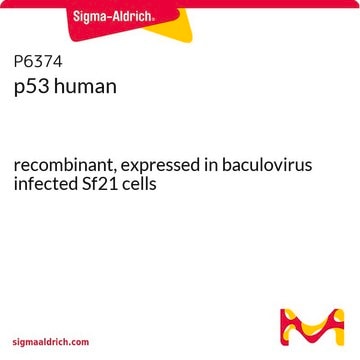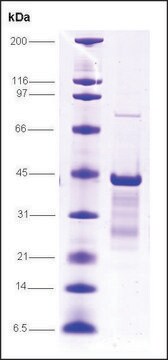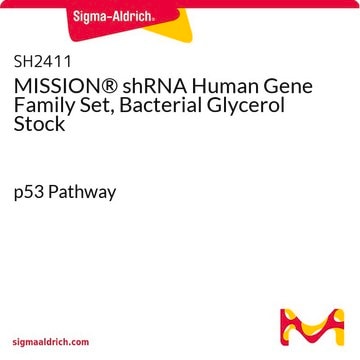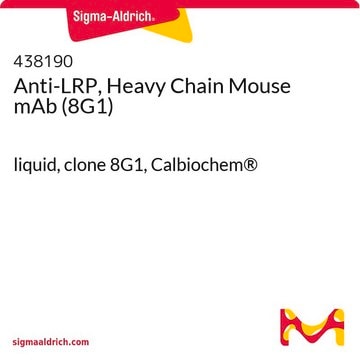SRP2077
p53 (1-363) C-terminal deletion human
recombinant, expressed in insect cells, ≥80% (SDS-PAGE)
Sinônimo(s):
FLJ92943, LFS1, P53, TRP53
Faça loginpara ver os preços organizacionais e de contrato
About This Item
Código UNSPSC:
12352200
NACRES:
NA.26
Produtos recomendados
fonte biológica
human
recombinante
expressed in insect cells
Ensaio
≥80% (SDS-PAGE)
forma
frozen liquid
peso molecular
~41.8 kDa
embalagem
pkg of 5 μg
concentração
850 μg/mL
cor
clear colorless
nº de adesão NCBI
nº de adesão UniProt
Condições de expedição
dry ice
temperatura de armazenamento
−70°C
Informações sobre genes
human ... TP53(7157)
Ações bioquímicas/fisiológicas
Human p53 protein is composed of 393 amino acid residues with several distinct regions. The N-terminal activation domain allows p53 protein to recruit the basal transcription machinery and activate the expression of target genes, whereas the core domain binds to target DNA in a sequence-specific manner and the majority of mutations found in human tumors occur in the region of the gene encoding this domain. The C-terminal domain is composed of predominantly basic residues and modification of the C-terminal basic domain, including acetylation, glycosylation and phosphorylation, is an essential mechanism for regulating p53 function.
forma física
Clear and colorless frozen liquid solution
Nota de preparo
Use a manual defrost freezer and avoid repeated freeze-thaw cycles. While working, please keep sample on ice.
Código de classe de armazenamento
10 - Combustible liquids
Classe de risco de água (WGK)
WGK 1
Ponto de fulgor (°F)
Not applicable
Ponto de fulgor (°C)
Not applicable
Certificados de análise (COA)
Busque Certificados de análise (COA) digitando o Número do Lote do produto. Os números de lote e remessa podem ser encontrados no rótulo de um produto após a palavra “Lot” ou “Batch”.
Já possui este produto?
Encontre a documentação dos produtos que você adquiriu recentemente na biblioteca de documentos.
X Chen et al.
Genes & development, 10(19), 2438-2451 (1996-10-01)
It is well established that induction of the p53 tumor suppressor protein in cells can lead to either cell cycle arrest or apoptosis. To further understand features of p53 that contribute to these cell responses several p53-null Saos2 and H1299
W S el-Deiry et al.
Nature genetics, 1(1), 45-49 (1992-04-01)
Recent experiments have suggested that p53 action may be mediated through its interaction with DNA. We have now identified 18 human genomic clones that bind to p53 in vitro. Precise mapping of the binding sequences within these clones revealed a
M Hollstein et al.
Science (New York, N.Y.), 253(5015), 49-53 (1991-07-05)
Mutations in the evolutionarily conserved codons of the p53 tumor suppressor gene are common in diverse types of human cancer. The p53 mutational spectrum differs among cancers of the colon, lung, esophagus, breast, liver, brain, reticuloendothelial tissues, and hemopoietic tissues.
Nossa equipe de cientistas tem experiência em todas as áreas de pesquisa, incluindo Life Sciences, ciência de materiais, síntese química, cromatografia, química analítica e muitas outras.
Entre em contato com a assistência técnica








